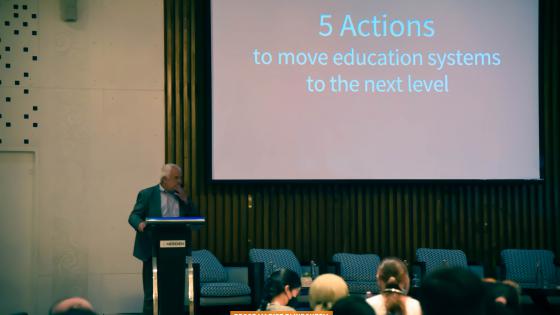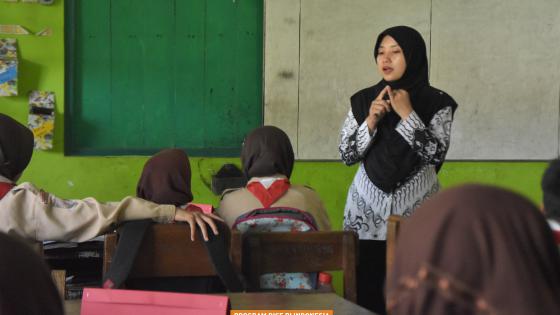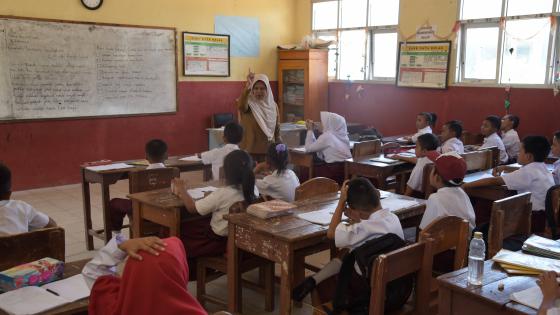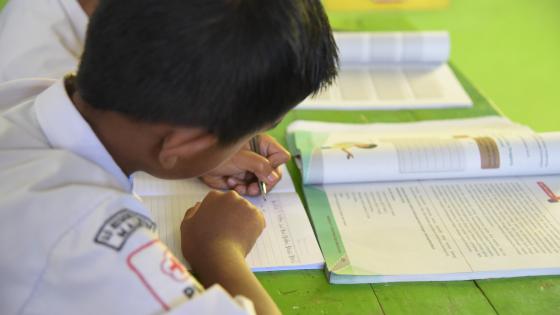Indonesian students' competency scores in reading, mathematics, and science in 2018 were lower than in similar assessment in the previous three years. Instead of improving, last year's reading skill score was equivalent to 2000.
This bad news came after the Ministry of Education and Culture released the results of the 2018 Programme for International Students Assessment (PISA) on 3 December.
The results of the global assessment for 15-year-old students showed that the average score of Indonesian students was 371 in reading, 379 in mathematics, and 396 in science. These scores were below the average scores of 79 PISA participating countries, 487 for reading skills and 489 for mathematics and science skills.
In the previous 2015 PISA test, Indonesian students recorded higher average scores in all skills of 397, 386, and 403 for reading, mathematics, and science skills respectively.
Why did Indonesian students’ assessment results in the global study, held every three years, drop significantly? The poor results of students' literacy skills at the 2018 PISA surprised many, particularly after the School Literacy Movement (Gerakan Literasi Sekolah/GLS) was introduced in 2016.
From the PISA report, it is acknowledged that the low quality of teachers and the disparity in education quality in Indonesia are thought to be the main causes of poor student literacy skills in general. Another cause, in my opinion, is that the GLS has failed to improve the literacy quality of students.
PISA Test Model
PISA is a global study in assessing the competencies of 15-year-old students in mathematics, science, and reading. The test, organised by the Organization for Economic Cooperation and Development (OECD), was attended by seventy-nine countries, ranging from developed and developing countries. The model of the test questions is the same for each participating country. These questions are translated into the language of each country.
The PISA test is not intended to assess students' mastery of curriculum content but to learn whether students can apply the knowledge they have learned in situations they encounter in their everyday life.
Indonesia has participated in the PISA test since 2000. In this test, students' skills in each field are referred to as reading literacy, mathematics literacy, and science literacy.
This assessment is held every three years, with a different focus for each implementation. The recently released PISA results are from the 2018 PISA test focusing on reading literacy skills.
Low literacy
The 2018 PISA results showed that 70% of Indonesian students could not reach level 2 in the PISA framework. The Indonesian students’ results are very worrying as, on average, only approximately 23% of students of the 79 PISA participating countries were unable to master level 2 reading skills.
The PISA level 2 questions expect students to be able to determine the main idea of a text, find connections between various information in a text, and draw a simple conclusion from a reading text.
The low literacy level is a fundamental problem that has an extensive impact on the nation’s progress as most of the more advanced skills and knowledge are acquired through reading activities. A skilled-reader community—able to read, comprehend, evaluate, and filter information—will be able to gain maximum benefits from reading resources.
Low literacy contributes to a country’s low productivity, that is the output produced by the country in a certain period.
Low productivity will affect the level of welfare characterised by low income per capita, the level of income of all people in a country if it is evenly distributed. Low literacy also contributes significantly to poverty, unemployment, and inequality.
The results of the RISE Programme–The SMERU Research Institute studies predicted that the average reading skills of Indonesian students will only be equal to the average skills of students of OECD countries in 2090 if there is no serious effort to improve the quality of education in Indonesia.
Teachers who hinder learning
One of the aspects studied in the PISA study to explain student learning achievement is the quality of teachers. The PISA study gathered information from principals whose students participated in PISA, on the characteristics of teachers who hinder student learning.
The results of the 2018 PISA study showed at least five teacher qualities in Indonesia that may be hindering learning:
- Teacher who does not understand students’ learning needs.
- Teacher who is often absent.
- Teacher who tends to resist changes.
- Teacher who does not prepare the lesson well.
- Teacher who is not flexible in the learning process.
PISA is tested on 15-year-old students in Grade 3 junior secondary school or early senior secondary school. Student achievement in PISA is the accumulation of their learning since the primary education level. The problem of teacher quality is inseparable from the low competencies of teachers in primary and secondary education units.
The results of a study conducted by my colleagues and myself found that only 12% of primary school teachers felt they had mastered teaching materials of reading literacy, and 21% thought they had mastered mathematics teaching materials.
The promotion of the GLS movement, which is expected to actualise President Joko Widodo's nine priorities agenda (Nawa Cita), seems hard to achieve its target without enhancing the competencies of the right teachers in facilitating literacy learning.
Disparity of education quality
Data from the Ministry of Education and Culture indicates a significant increase in access to education in Indonesia, marked by the rise in the percentage of the population aged 15 years who attend school. However, this increase in access is not parallel with an increase in quality.
Last year's PISA test represented 85% of the Indonesian population aged 15 years, while the 2003 PISA, for example, only represented 46% of the Indonesian population in that age group. In 2018, there were 399 education units with 12,098 students who took the PISA test. Each province has a sample representative.
This increase in representation is considered as one of the factors that can explain the decline in student achievement in the 2018 PISA.
The Head of the Agency of Research and Development of the Ministry of Education and Culture stated that the increasing number of representation in the 2018 PISA and the inequality in national education quality were thought to have influenced the final results of the PISA test. The scores of students in areas where the quality of education is poor “have contributed to the low” national average scores.
For instance, students in the Special Regions of Yogyakarta (DIY) and Jakarta had average scores of 411 and 410, respectively, in reading skills. This indicated that the reading skills of students in the two regions are considered on par with students in Malaysia and Brunei Darussalam. Meanwhile, students in other parts of Indonesia showed significantly lower reading skills, with a national average score of only 371.
The good results in DIY, particularly in the City of Yogyakarta, can be explained by the various efforts made by the regional government and the active participation of the community to support the GLS through mobile library activities and a culture of good reading literacy in the community.
School Literacy Movement
The School Literacy Movement, or Gerakan Literasi Sekolah/GLS, introduced in 2016, was expected to improve the literacy skills of school-age students. This movement encouraged the establishment of literacy corners and literacy stages in schools. This movement is also supported by the provision of the Community Reading Park (Taman Bacaan Masyarakat/TBM) outside schools.
The results of the 2018 PISA did not reflect the effectiveness of GLS and TBM in increasing reading literacy skills. This is due to, among others, reading books that are not appropriate for the age and interests of students and the lack of support from parents and the community in fostering a reading culture.
GLS also targets literacy in numeracy and science. To strengthen these two fields, it is unfortunate that the Ministry of Education only recommends extracurricular activities, such as math and science clubs outside of classroom learning activities. Generally, these clubs are attended by a small number of students who already have interests and talents in these fields.
Many students who joined the math and science clubs are then prepared to take part in science olympics. Meanwhile, to sort out problems with students' low competencies in mathematics and science literacies, it should target school-age students in general through strengthening learning activities in classrooms.
Coming out of the pool of problems
Having the diagnosis of Indonesian student competencies from the PISA survey, it is necessary to follow up by improving the quality of teachers, reducing educational disparities, and implementing various educational programmes systematically and comprehensively.
The teacher education and training system, as well as the teacher placement and recruitment systems, are two matters that are urgently needed to be sorted out.
In addition, the assessment system and curriculum that have been the main guidelines for teachers in teaching need to be reviewed so as not to direct them further to become teachers who hinder learning.
Active participation from parents and the community in cultivating a learning culture is also needed to synergise these programmes. It takes commitments from all parties to succeed in government programmes such as the GLS so that it does not remain a slogan.
As the Minister of Education and Culture Nadiem Makarim said, the dream of being able to reach an average achievement equivalent to OECD countries in PISA can only be achieved with optimism and hard work from all parties.









